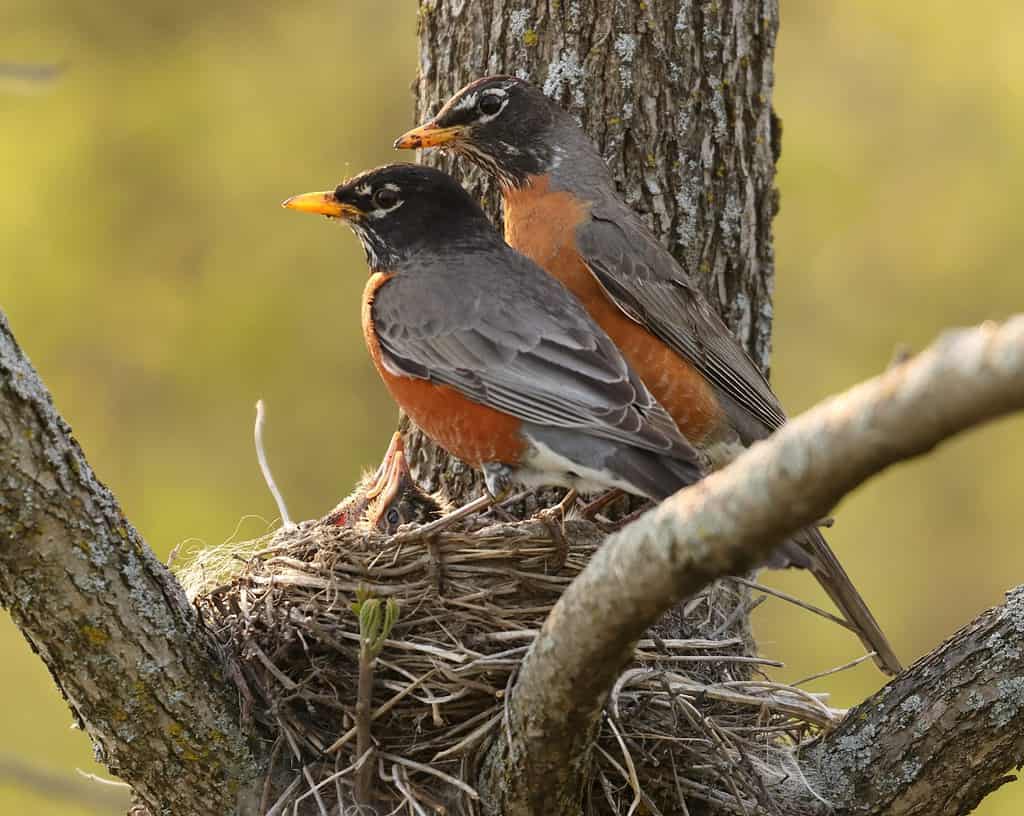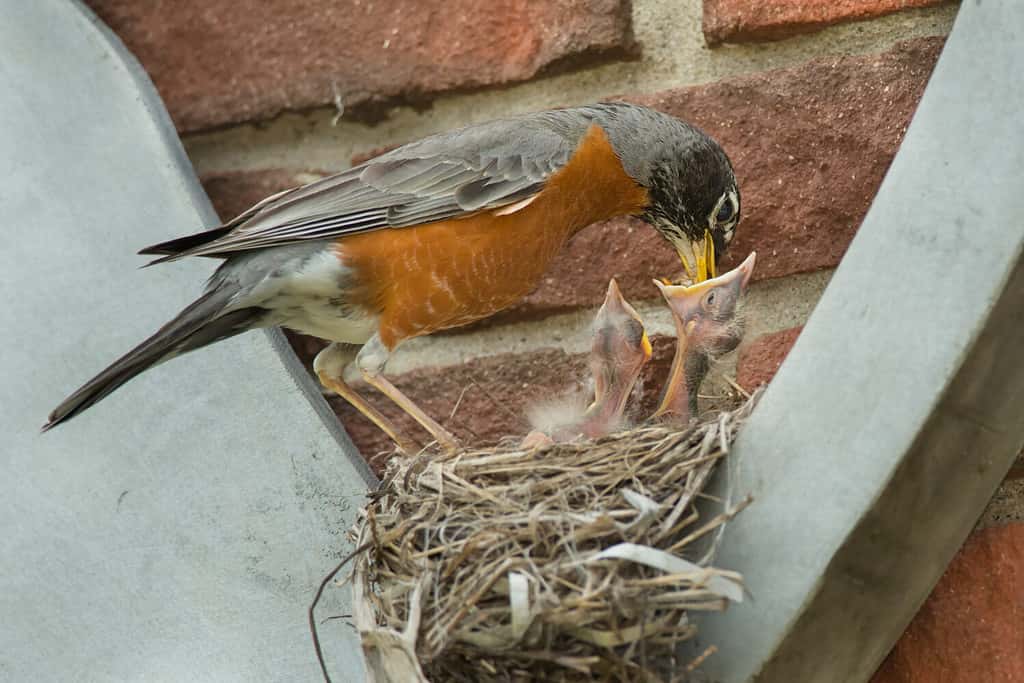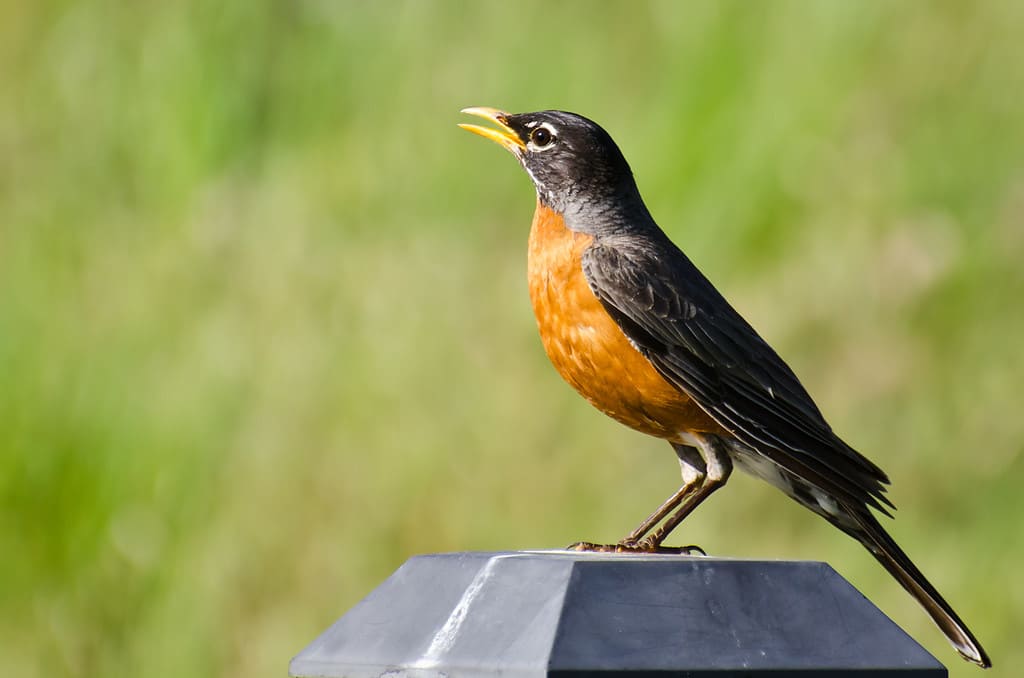How do you know if a robin’s getting ready to nest? You’ll see them gathering materials.
If you spot a robin flying around with bits of leaves, grass, and twigs; it’s probably preparing the nesting site. But that doesn’t mean there’s going to be baby birds anytime soon. Robins will construct their nest as early as three months before any eggs arrive. These stick-woven nurseries can then house as many as five baby birds in a single brood.
What else should you know about these famous songbirds? Follow along as we learn all about robin nests, eggs, and more.
Nest Placement: Robin Nest

Robins prefer to nest closer to the ground and often choose lower tree limbs over higher ones.
©yvontrep/Shutterstock.com
Robins have a reputation for nesting anywhere they can. They’ll nest in trees, hedges, wood piles, buildings, logs, and anywhere else they find available. These clever birds have been found nesting in lanterns, flower pots, mailboxes, wood piles, and car trunks.
Here are a few of the robin’s favorite places to nest:
- Robins nest lower to the ground
- Nests can be as low as 5 feet above ground
- Nests can be as high as 20 feet above ground
- Lower tree limbs
- Hedges
- Mailboxes
- Light fixtures
- Gutters
- Wood piles
- Unused cars
Robins prefer to nest in quiet places that are low to the ground. Lower tree limbs are always preferred over high-up ones, and sometimes these birds even wind up on the ground. Overall, robins try to choose spots where they won’t be disturbed.
Common Nesting Materials
Female robins construct the nest using dead leaves, fine grass, mud, feathers, moss, roots, and twigs. They’ll even use paper as a nesting material if it’s available.
Here’s a list of robin nesting materials:
- Dead leaves
- Dead grass
- Mud
- Twigs
- Roots
- Hair
- Paper
- Moss
The female is responsible for constructing most of the nest. Using one wing she’ll build the nest from the inside out. Materials like grass, moss, and twigs help form the walls of the nest. Once a cup shape is formed with the dry materials, the mud acts as the glue holding it all together. Robins also love to line their nests with hair. Nest sizes vary, but it’s common for a nest to be about 4 to 6 inches wide, and 6 inches deep.
What a Robins Nest Looks Like

Robin nests can range in size but it’s common for them to be about 4 to 6 inches wide and deep.
©Paul Reeves Photography/Shutterstock.com
How will you know if you’re looking at a robin nest? The famous blue eggs can be a clear giveaway. But what if there aren’t any eggs present? Then it’ll be a little trickier to make an identification.
Robin nests look like a lot of other bird nests. The classic woven cup design made out of twigs and grass is popular among many songbirds. Since the materials won’t help distinguish the nest, take note of its size.
If the nest is gigantic, like a foot long, it likely belongs to a large songbird such as a raven. Even bigger nests likely belong to a bird of prey, such as an eagle. But if the nest is less than 8 inches wide and deep, it could belong to a smaller-sized songbird, like a robin.
Robin nests are about 6 inches wide and 6 inches deep. They have a round bowl shape large enough to house a softball. In comparison, a cardinal’s nest is only about 3 inches wide and 3 inches deep.
What to Do if You Find a Robins Nest

Robins are protected by the U.S. Migratory Bird Protection Act, just like hummingbirds and wrens.
©RCKeller/iStock via Getty Images
Did a robin choose your home to lay its eggs? It’s not uncommon for nesting birds to take advantage of sheds, porches, and decks. If you come across a nest, you should leave it alone, and do what you can to give the birds plenty of room. Robins aren’t an invasive species, and they’re protected by the U.S. Migratory Bird Protection Act, just like hummingbirds and wrens.
As long as the birds are left alone they should be able to raise their young without an issue. Once the fledglings are grown, it’s wise to leave the nest alone for a few more days. Sometimes the young return to the nesting site a couple of times.
After a few weeks of no activity, it’s safe to remove the nest, or you can just leave it be. Since robins usually build a new nest each year, your avian house guests aren’t likely to return.
When Do Robins Nest?
The early bird doesn’t just get the worm, they get the best nesting spots too. If the weather permits, robins nest around January, which is early for the bird world. After making the nest, the robins will leave it alone it alone until they’re ready to use it.
Breeding season starts around March, and the eggs arrive in the middle of April, and on through August. A clutch usually consists of three to five sky-blue eggs. Sometimes the eggs have more of a blue-green color. When the eggs hatch the baby robins are featherless and completely dependent on their parents to survive. It takes about two weeks for these tiny baby birds to leave the nest.
Where Are Robins Most Active?
Robins are a sign of spring, with their bird song ringing out just before sunrise. These widespread birds can be found throughout North America and Canada. Some live in the United States year-round, while others migrate to Alaska during the summer. Preferred habitats include coniferous forests and lots of berries. They also prefer lowland suburbs, grasslands, farms, and city scenes.
American Robins Love Texas
Texas is proud to be a year-round home to the American Robin. If you’re in the state between November through late March, you’ll get to see a lot of these lively birds. This is when the migrating birds visit the state, which helps boost the breeding population. Like other locations, the American robins in Texas prefer nesting in the open farms, woodlands, and cities.
The photo featured at the top of this post is © yvontrep/Shutterstock.com
Thank you for reading! Have some feedback for us? Contact the AZ Animals editorial team.







